How To Find Leak In Inground Pool Piping
So it'southward that time of year again. The weather is getting dank and you are worried about your pool pipes freezing.
One question common amid pool owners is how long does it take for pipes to freeze solid? Another question is what temperature to shut the puddle? The answers to these questions and more than will be revealed in this post.
Allow's dive in.
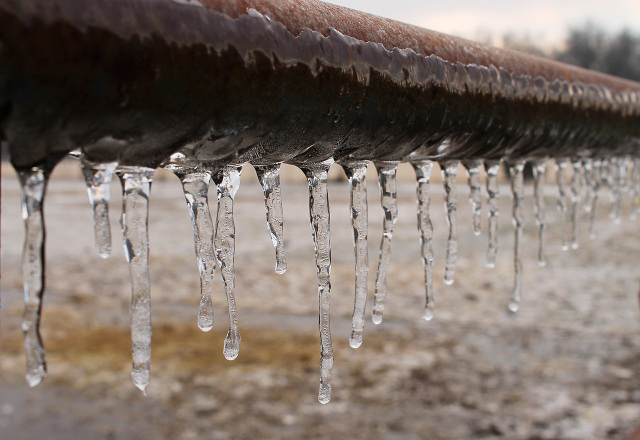
Why Exercise Puddle Pipes Freeze?
Outset things offset, it's not the pool pipes that freeze but the water in the puddle pipes. When the pool doesn't have any prevention confronting extreme atmospheric condition, the water will freeze up when the weather condition temperature gets below freezing.
Frozen pool pipes are more than common with above-footing pools. This is considering the pool plumbing and filter system are above footing.
Inground puddle pipes besides freeze, merely it isn't as common since the puddle pipes are normally installed hugger-mugger. However, even though the water in the clandestine section of the pipes may not freeze equally easily, the h2o in pipes at the surface of the pool will freeze. The skimmer, pool pump and filter are equally prone to freezing.
So how long does it take the pool pipes to freeze? Let'southward find out.
How Long Exercise Pool Pipes Accept To Freeze?
Above ground pool pipes volition freeze in under 6 hours if exposed to weather temperatures beneath 32° F (0 °C) if they are not protected from the cold. Inground pool pipes will take five – 7 days of continuous temperatures below 32°F (0°C) to freeze up.
These times practise vary and in that location are several factors that will determine how long information technology takes for pool pipes to freeze.
H2o freezes when exposed to cold temperatures at or beneath 32 degrees Fahrenheit (or 0 degrees Celsius). Withal, the time it takes for the pool pipes to freeze largely depends on the blazon of pool, where the pool is, the location of the pipes and the temperature of the air.
Above ground pool pipes freeze up quicker than in-footing pools because the in-ground pool pipes are buried secret, giving the pipes some sort of insulation. Plus the world's surface is colder on top.
Besides, puddle pipes will freeze quicker at night and when the water level in the pool is low.
The weather is colder at night and if the water level is low, the pool system volition suck in cold air, making the pipes freeze up faster.
For indoor pools, frozen pipes is not common since the pool arrangement isn't exposed to the freezing outdoor conditions.
For inflatable pools, the water will begin to freeze inside an hour if exposed to extreme cold temperatures. This is considering inflatable pools are poorly insulated.
How Common cold Does It Demand To Exist For Puddle Pipes To Freeze Solid?
The conditions needs to be at or below xx degrees Fahrenheit (-6.7° C) the puddle pipes to freeze solid. At 32°F (0°C), h2o will begin to freeze up and will eventually freeze solid only after some hours or days.
Notwithstanding, at 20 degrees Fahrenheit, most pools pipes will freeze over solid quickly. Even insulted puddle pipes volition struggle to continue the water temperature above freezing when the atmospheric condition drops to or below 20°F (-6.7°C).
Then what happens in the puddle when the pipes start to freeze? The quick answer is the pool equipment volition get damaged. For the detailed answer, keep reading.
The Dangers of Frozen Pool Pipes
When the pool pipes get frozen, the pool plumbing is at run a risk. As explained before, it's not the puddle pipes that freeze. It's the water in the pool pipes that gets frozen.
When a water molecule freezes, information technology can expand up to 9% due to its dumbo nature. And if the water has nowhere to go, the only choice is for the puddle pipes to expand. It's this expansion that can cause cracks in the pool plumbing. Metal and PVC pipes are both prone to breaking.
Frozen puddle pipes can too cause the pool pipage unions and fittings to become loose assuasive absurd air to go in and cause the pipes to freeze solid. Loose pipage unions and fittings can likewise cause leaks when you run the puddle arrangement.
Simply that's not all. Permit's check out another dangers of frozen puddle pipes.
Damaged Pump System
Your pool pump tin can be damaged by freezing temperatures. This trouble is exasperated when seals are loose or cracked o-rings, which will allow air to get into the pump system. The cold air sucked in causes the water running through the pump arrangement to freeze up.
Since puddle pumps are largely fabricated from plastic, the plastic material tin can easily crack due to expanding water. The worst part is, yous likely won't discover the cracks considering until you run water through the pump again – the issue will show up as leaks.
If this happens, it'due south time for a new pump.
Cracked Pool Filter Housing
The filter housing or canister is at risk of beingness cracked from expanding ice. Though pool filters housings are designed to handle increased pressure, the canister can only have and then much.
As the ice expands quickly, the canister will expand to the point of breaking and damage the filter across repair. Commonly, this damage is pretty obvious, but sometimes it won't exist noticeable until the spring when you outset your pool once again.
Tip: If you tin can see water dripping or leaking from the top of the filter housing during winter, it's usually a sign of freeze damage.
Damaged Pool Walls
In frosty cases where the ice starts to form on the water surface in the puddle, and then the whole puddle is at chance of tearing up. For above-ground pools, the pool walls will be stretched as the water ice spreads across the pool water.
For in-basis pools, the expanding ice can crack pool walls or damage the puddle surrounds, causing thousands of dollars in repairs.
Croaky Skimmer Box
Ice damage in skimmer boxes is particularly common. When the h2o freezes information technology expands. And if the expanding water has nowhere else to go, it will push on the sides of the skimmer box, causing information technology to crack. This isn't repairable.
You can however use something chosen a gizzmo. Don't worry, this isn't Gizmo from the Gremlins motion picture.
A gizzmo for your pool is a small plastic hollow device that is inserted into the skimmer box. Since the device is hollow, when the water freezes and the ice expands, the ice volition expand into the device, crushing it in the process, which protects your skimmer box.
Hither'southward a Gizzmo you can use hither:
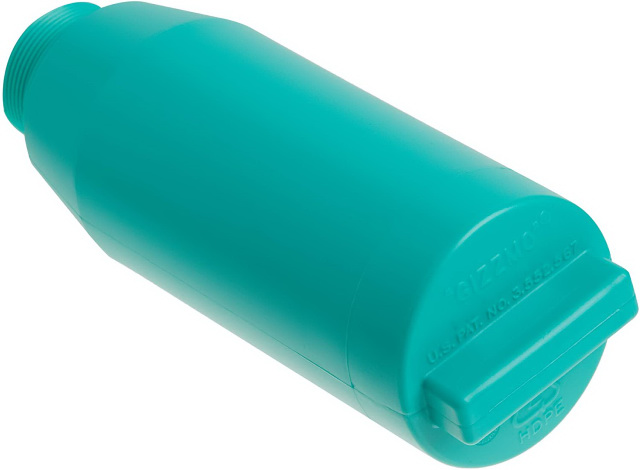
Click here to check the price >>
Many pool owners believe cloak-and-dagger pool pipes will not freeze since the pipes are buried. Is this truthful? Let'southward find out.
Volition Underground Pool Pipes Freeze?
Underground pool pipes can freeze in cold climates when the temperature is below 20°F (-6.vi°C) for several days. If the pipes are buried less than 2ft (61cm) and the soil is moist or particularly porous, the pipes are much more probable to freeze.
The parts of the pipes that extend out of the footing are much more susceptible and volition definitely freeze afterwards several days of sub-freezing temperatures.
The biggest factor for underground pool pipes to freeze, after the temperature, is the depth the pool pipes are cached and the frost line of the soil. For clandestine pool pipes to freeze, frost has to travel into the soil to get to the pipes. The deeper the pipes are buried, the less likely pool pipes are to freeze.
The standard pool pipe depth for in-ground pools is well-nigh 2ft below ground level. For pool pipes to freeze at this depth, frost has to penetrate about 25 inches into the ground. This is where the soil frost line comes in.
The frost line refers to the depth at which underground water will freeze. In other words, information technology refers to how deep the frost has to penetrate the soil for pipes underneath to freeze. The average frost line is but over xx inches (less than 2 anxiety) into the ground.
If the frost line in your area is greater than 30 inches, so pool pipes buried 2 feet below the ground will be affected, but it will accept several days of abiding frost penetration in the soil for the pipes to freeze.
Also, the status of the soil matters. If the soil has a lot of wet content, so the pool pipes will freeze easily. And if the soil is very porous, then frost can travel down quicker and get to the pool plumbing.
Will Running The Pool Heater Foreclose Pool Pipes From Freezing?
Running the pool heater will prevent the puddle pipes from freezing if the heater is powerful enough and is run for long enough. Information technology will exist expensive to run a pool heater throughout winter, though.
Here's a more than in-depth answer.
Offset, the weather temperature must exist to a higher place twenty degrees Fahrenheit. If the atmospheric condition temperature drops to or below xx degrees, the puddle heater will struggle to proceed the water higher up freezing (or to a higher place 32 degrees F).
Too, the pool heater must exist left running long enough to keep the pool water above 32 degrees (0 degrees Celsius). The standard time frame is to continue the heater running for at to the lowest degree 12 hours a mean solar day during the winter months.
Lastly, the pool heater should be capable of producing the required amount of oestrus to go along the pool water temperature to a higher place freezing. So if you are using a minor pool heater for a large pool, information technology won't cut information technology during the winter.
Tip: Running the heater at dark when the weather is colder helps to foreclose pipes from freezing. Too, covering the pool at nighttime, with a puddle cover, and while the pool heater is running, helps to retain rut and save price.
Will Running the Pump Preclude Pool Pipes Freezing?
Running the pool pump volition slow downwardly the rate at which the puddle h2o and pipes will freeze. Pool h2o and pipes will somewhen freeze regardless of if the water is moving or not if the temperature drops beneath 32°F (0°C. The time it takes to freeze depends on temperature, if the pipes are insulated and if they are hole-and-corner or above ground.
Many pool owners believe that if their pool system is kept running, the water can't freeze. This is simulated.
Don't believe me? Hither is why.
Each water molecule is made of hydrogen atoms (the positive charge) and oxygen atoms (the negative charge). As the h2o moves, the molecules rub confronting each other creating rut that makes the water warmer.
However, the heat produced only keeps the water from freezing when the temperature is around xxx°F (-1.1°C). If the temperature drops well below thirty°F (-ane.i°C), the heat produced by the water molecules will exist very insignificant.
The water molecules volition gradually lose charge and motion slower. The colder the temperature gets, the slower the water will move till it gets to a phase where the water becomes semi-solid or soft ice. When water gets to this stage, it can't motion.
Since there is no water move. there is no heat from the water molecules. Eventually, the water volition freeze solid.
What Temperature Should I Close My Pool?
If y'all're not going to be pond and let'southward face it, almost of us won't, you lot can close your puddle off for the winter at around 50°F (ten°C). But you could let it go until the temperature is effectually freezing.
If you do permit the temperature get to freezing, make sure you take a freeze damage prevention measure in place.
If your pool pipes are well insulated, or you have a freeze baby-sit installed, and so yous tin can leave your puddle open up. But be prepared to accept on an extra pool maintenance workload. One result with this is that if the power goes out and your pool pump stops, the skimmer and filter will freeze at around 30°F (-i°C). And that will be expensive if that happens.
If the pool pipes aren't insulated and you don't have a freeze guard installed, and then you should shut your pool when the temperature is above freezing to prevent freeze impairment.
Let's check out some other ways to prevent freeze damage and pool piping freezing in your pool system, for those pool owners that want to have on the winter.
How To Protect and Prevent Puddle Pipes From Freezing
The following prevention methods should but be used when the weather temperature is above 20°F (-half-dozen.7°C).
If you live in frosty climates or areas where the conditions temperature drops to or below 20°F (-6.7°C), your best bet is to winterize or close the pool. Observe out how to do that:
How to Close and Winterize an Inground Pool
How to Close and Winterize an Above Ground Pool
Here are a few means to prevent pool pipe freezing:
1) Keep The Pump Running
A adept way to forbid freeze damage is to go on the puddle running 24/seven. This helps to maintain water temperature by keeping the h2o flowing. As the water circulates, heat is produced and it becomes more than hard for pipes to freeze up.
You should know that running the pool organization alone can't continue your pool water from freezing through the winter months.
Tip: Variable speed pool pumps are ideal for winter months. The puddle pump allows you to alternate between different speeds which means you can run your pump very slowly near of the time, saving you electricity.
2) Insulate the Pipes
You lot can also prevent pool pipes from freezing by insulating the pool plumbing. Y'all can do this by:
- Wrapping towels and blankets around the pool pipes.
- Using puddle insulation tapes. These tapes can be wrapped around pool plumbing and they are ordinarily made from materials like foil that retain oestrus.
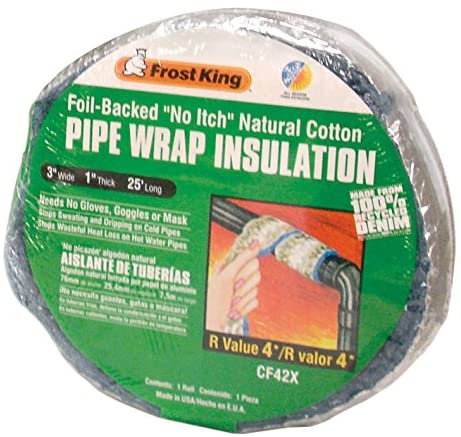
Click here to check the cost >>
3) Maintain Proper H2o Level
If you lot plan to leave your pool open during winter, always ensure that the water level is near mid-style up the skimmer. If the water level is beneath the mid-point of the skimmer, then the puddle arrangement will be starved of water.
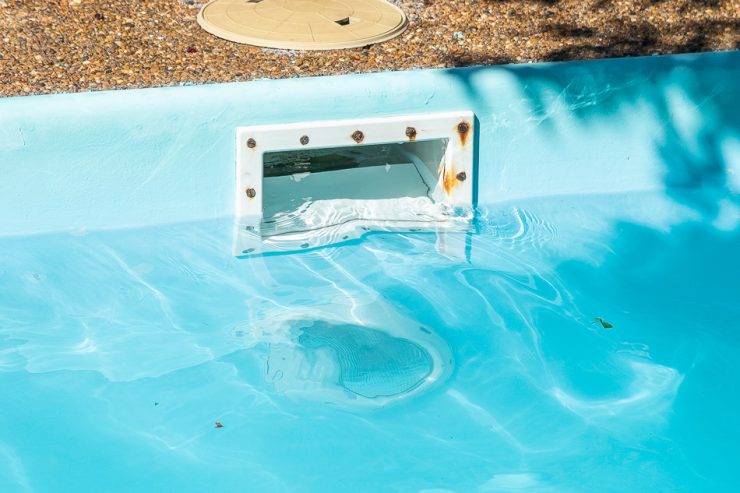
4) Install Freeze Protection Timers
Freeze protection timers or freeze guards are devices that automatically run the puddle system when the temperature gets around freezing.
Freeze protection timers are designed with temperature sensors. The sensor detects when the weather is creeping towards freezing temperatures and switches on the pool pump automatically to slow down freezing.
Freeze protection timers are bang-up for decorated pool owners that want to continue the pool open during wintertime. Here are some great choices.
Intermatic freeze protection control. This production turns on the pool pump and heater (if installed) based on the gear up temperature past the user.
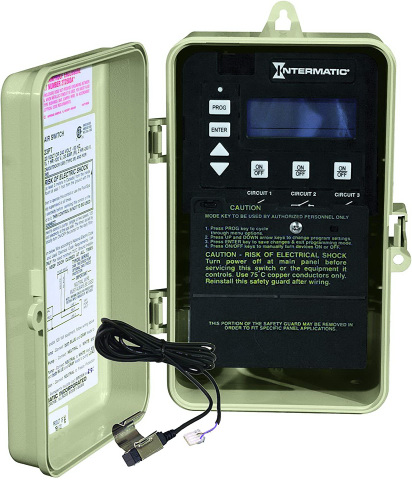
Click here to check the toll >>
Intermatic PE153PF freeze protection. This product has upward to 7 pre-programmed combinations to cull from and it can control both single speed and dual speed pool pumps.
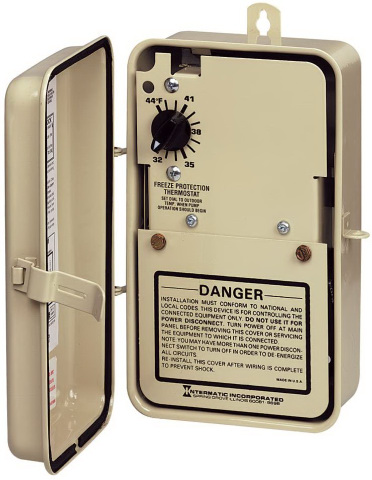
Click here to cheque the price >>
You should know that keeping your pool open during the cold months is expensive as you have to pay more to continue the pump running. You lot may also have to buy actress pool equipment and insulation pads.
So if yous are on a tight budget, it's best to close the puddle for the winter.
Final Thoughts
Overall, freeze damage is a serious business and information technology can happen to anyone regardless of the type of puddle. Simply with proper prevention methods, you lot tin can extend your swim time during the wintertime so you don't have to shut the pool.
E'er recall that all prevention measures are subject to the weather temperature. If it gets too cold, it's best to winterize the pool.
Source: https://www.myperfectpool.com.au/preventing-pool-pipes-freezing.html
Posted by: pullumthempling.blogspot.com


0 Response to "How To Find Leak In Inground Pool Piping"
Post a Comment